Abstract
This paper investigates the expected costs of cash transfers to children in South Africa up to 2015. The child population is not expected to grow between 2008 and 2015 and thus the fiscal cost of the Child Support Grant is expected to stabilise in the near future. The other major child grant, the Foster Care Grant, is far less predictable – while it is not intended to be an orphan grant, three quarters of its beneficiaries are orphans. Because of the HIV/AIDS pandemic, the number of dual orphans is expected to double between 2008 and 2015, reaching 1.3 million, and the overall number of orphans (maternal, paternal and dual) to reach 4.8 million by 2015. If the Foster Care Grant were to become a de facto orphan grant, its costs would escalate rapidly. The paper does not argue in favour of an orphan grant, but rather for greater effort in ensuring that the Child Support Grant reaches the neediest children, especially maternal orphans.
1. Introduction
South Africa currently has one of the largest and most ambitious social assistance programmes in the developing world. Government spending on cash transfers has increased markedly since the end of apartheid, reaching just over R80 billion, or 3.3% of GDP, in the 2009/2010 financial year (National Treasury, Citation2010). Using the base wave of the National Income Dynamics Study (SALDRU, Citation2008), we estimate that about 60% of all children under the age of 15 and over 70% of elderly men and women received a grant in 2008. A large literature exists demonstrating that the grants are well targeted and have a significant impact on breaking the intergenerational transmission of poverty (for a review see Woolard & Leibbrandt, Citation2010). A question that has received less attention is the fiscal impact of this rapidly expanding system. This paper examines this question with specific reference to child grants, namely the Child Support Grant and the Foster Care Grant. In particular we focus on the fiscal implications for the child grants of high AIDS-related mortality of prime age adults. This increased mortality translates into increased orphanhood and altered living arrangements for children, which in turn has implications for the system of cash transfers to children.
In this paper we use recent data from the base wave of the National Income Dynamics Study (NIDS) to investigate the profile of child grant beneficiaries and to model the possible evolution of the system up to 2015. We take the key demographic trends from the Actuarial Society of South Africa (ASSA) 2003 model. We consider the costs of various simulated orphan grants and juxtapose them with the costs associated with increasing take-up of the Child Support Grant of the Child Support Grant among maternal orphans, showing that these orphans are the least likely to access the existing system.
2. The history of child grants in South Africa
State assistance to children has changed markedly since the end of apartheid. Prior to 1998, direct support for children was limited to children in very specific circumstances through the State Maintenance Grant, the Care Dependency Grant and the Foster Care Grant.
The State Maintenance Grant was intended for a parent or guardian living with a child under 18 years of age if the applicant was unmarried, widowed or separated, had been deserted by their spouse for more than six months, had a spouse who received a social grant, or had a spouse who had been in prison, a drug treatment centre or a similar institution for more than six months. Applicants had to prove that they had made efforts to apply for private maintenance from the other parent but had been unsuccessful in doing so. There were limits not only on non-parent receipt of the grant, but also on eligibility with regard to children born outside of marriage. As a result of significant differences between the rules for the various race groups and also how they were applied, very few African children and their caregivers received the grant. In 1990 an estimated 0.2% of African children, 1.5% of white children, 4% of Indian children and 4.8% of coloured children were receiving the State Maintenance Grant (Kruger, Citation1998).
In April 1998 the State Maintenance Grant was abolished and the Child Support Grant was established. The purpose of this new grant was to provide support to more children: the poorest 30% were targeted at a lower grant value. To this end, eligibility was dependent on a household's income falling below a certain threshold. Take-up rates were initially very low and the eligibility rules were changed in 1999. From that year, caregiver or spousal income was used for the means test instead of household income. The threshold level was set at R800 per month for formal urban areas and R1100 per month for rural areas and informal settlements. This level remained unchanged from 1998 up until 2008, meaning that caregivers had to be progressively poorer in real terms each year to qualify for the grant.
The original age limit for eligibility was set at children under 7 years old. In 2003 it was increased to children under 9, and a year later to children under 11. In 2005 the age limit was raised to children under 14. In 2009 it was raised again to children under 15, and in 2010 to children under 16. Legislation has been put in place to ensure that the age limit increases to include 16 year olds in 2011 and 17 year olds in 2012, ending many years of lobbying by child advocacy groups to have the grant extended to all children under 18, in line with the Constitution. The grant amount was established as R100 per month in 1998 and increased annually after the first few years. In 2008 it was set at R230 and at the time of writing it was R270. Since the Child Support Grant was established in 1998 its coverage has grown remarkably, as can be seen in .
Figure 1: Child Support Grant take-up by age FootnoteNotes.

The Foster Care Grant existed prior to 1994 and was designed to provide financial support for ‘at risk’ children who had been placed in the custody of foster parents in terms of the Child Care Act. Examples of ‘at risk’ children would be those not being cared for by their parents and who are in danger of falling into homelessness, poverty, malnutrition, truancy or even crime. In terms of the Act, to be eligible for this grant the child's parents need not be deceased but, if living, they must be unwilling or unable to care adequately for the child. The Foster Care Grant amount is almost three times that of the Child Support Grant, standing at R710 per month in 2010 (although the gap between the two Grants has narrowed somewhat over recent years). To qualify for the Foster Care Grant, the child must have been placed by a court in the care of the foster parents. This placement process is a time-consuming and complex process. Social workers play a central role in the process and the current shortage of social workers exacerbates the time delays (Budlender et al., Citation2008). Each foster care placement must be ordered by the court and then reviewed by a social worker on a biannual basis, with an associated court-based process for each review. This process again requires the involvement of social workers in both the review and court appearances.
In spite of these administrative hurdles, the take-up of the Foster Care Grant grew rapidly after the end of apartheid, fuelled by the increased adult mortality and illness associated with the spread of the HIV/AIDS pandemic that has left large numbers of children in need of care. The number of recipients increased particularly rapidly between 2002 and 2006 (see ). As with the Child Support Grant, recipients often claim for more than one child and in the case of the Foster Care Grant the number of children claimed for per recipient has been decreasing over time.
Figure 2: Beneficiaries and recipients of the Foster Care Grant over time FootnoteNotes.
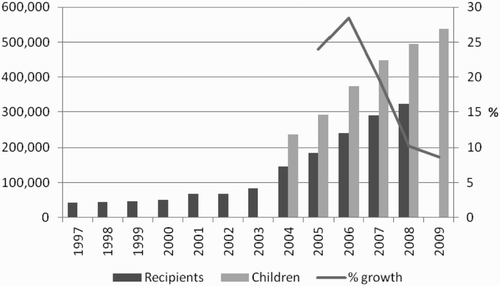
The use of the foster care system and grants for children orphaned by AIDS has been encouraged by certain government actors, including the former Minister of Social Development, Zola Skweyiya. Meintjes et al. (Citation2003:1) quote Minister Skweyiya as saying in 2002 that ‘The Department of Social Development is encouraging relatives to take care of orphaned children under the foster care package’. Similarly, on 6 November 2007, in the second reading debate on the Children's Amendment Bill in the National Assembly, the Minister emphasised the ‘importance of family preservation’ and highlighted a ‘provision for the placement of children with a family member’ (Skweyiya, Citation2007).
3. Changing dynamics of the Child Support Grant
3.1 Characteristics of beneficiaries
The Child Support Grant is reaching a substantial proportion of children. According to the South African Social Security Agency (SASSA), about 8.9 million children received some form of cash transfer in 2008. This equates to almost 60% of all children under the age of 14. Nearly all of these children were receiving the Child Support Grant, with only 5% receiving the Foster Care Grant and far fewer receiving the Care Dependency Grant (which goes to the caregivers of severely disabled children). Most of the children benefiting from child grants live in provinces which include former homelands: in 2008 more than a quarter of child beneficiaries lived in KwaZulu-Natal, another 18% in the Eastern Cape and 15% in Limpopo (personal communication, V Mahlangu, SASSA, 11 September 2009).
Using NIDS, we are able to attain much more detailed information on children and their adult grant recipients than the SASSA data possess. Of course, survey data cannot provide precise estimates of the number of beneficiaries, but they do provide rich insights into the characteristics and living conditions of recipients and beneficiaries. The NIDS survey asked the caregivers of children under 15 a range of questions regarding grants. According to the weighted NIDS data, about 8.5 million children were receiving a government grant in 2008, with 7.8 million of them receiving the Child Support Grant. These figures are close to the administrative figures obtained from SASSA which show 8.4 million children receiving the Child Support Grant in 2008 (personal communication, V Mahlangu, SASSA, 11 September 2009).
According to the NIDS data, most child grants are received by the child's parents (82%) while 12% are received by grandparents and 3% by an aunt or uncle. It is important to note that these relationships are determined through subjective self-reporting and are not necessarily biologically accurate. For instance, a recipient listed as a child's mother may in reality be the child's grandmother but viewed in the household as a mother figure. Almost all reported grant recipients are women. About a third of all recipients are in their thirties, with substantial shares also in their twenties and forties. Only about 2% of recipients are teen aged mothers.
3.2 New means test
The original means test for the Child Support Grant was problematic in many ways. Firstly, the threshold remained unchanged in nominal terms for 10 years, demanding an increasing level of real poverty to qualify. Secondly, married couples had to declare their combined income but were still subject to the same threshold as single caregivers, making it harder for married couples to qualify. Thirdly, different thresholds were applied depending whether an area was considered rural or urban, with the urban poor being subjected to a more stringent means test. In August 2008 the means test for the Child Support Grant was finally updated and is now set equal to 10 times the current grant amount. In this way, the threshold automatically keeps pace with inflation (provided that the grant amount is increased in line with increases in the cost of living). The geographic differentiation has been abolished and the threshold for married couples is now double that for unmarried caregivers.
These changes have meant that more children are now eligible for the grant. According to our simulations on the NIDS data, under the old regulations 7.8 million children would have been eligible, while 9.5 million children are estimated as eligible under the new regulations. According to the administrative Social Pension System (SOCPEN) data, 8 326 522 children were receiving the Child Support Grant in September 2008 (prior to the threshold changes) and 8 434 027 were receiving it in December 2008. This suggests a slow initial take-up after the change in the regulations, which is unsurprising given that people need to get to know about the change and the approval process takes some time.
3.3 Simulating eligibility
Eligibility was determined using the list of steps shown below that established who each child's ‘caregiver’ was most likely to be. To simulate whether or not a child was eligible for a Child Support Grant under the means test, we used a series of steps to assign caregivers to children, a caregiver being the person most likely to apply for a grant on behalf of the child. The steps were as follows:
| • | If the child is reported in the survey data as receiving a grant, the named recipient is taken as given. | ||||
| • | If not, and the child's mother is resident, then the recipient is assumed to be the child's mother. | ||||
| • | If not, then the recipient is assumed to be the person listed as the child's caregiver in the survey. | ||||
| • | If not, then the caregiver is assumed to be the oldest female resident in the household. | ||||
| • | If no adult females are resident in the household, then the caregiver is assumed to be the household head. | ||||
All children with simulated caregivers younger than 16 were reassigned to older household members.
illustrates the difference between the NIDS and SASSA Child Support Grant beneficiaries by age. While greater noise by individual age was expected in NIDS due to the sample size, the age profile was fairly similar, with the notable exception of the age group 0–4 where NIDS underestimated the number of beneficiaries. Population surveys consistently suffer from an underestimate of very young children, in particular infants, so this result was to be expected. This age category also exhibited a slightly higher rate of non-response on grant receipt.
Figure 3: Child Support Grant beneficiaries and eligibles, October 2008 FootnoteNotes.
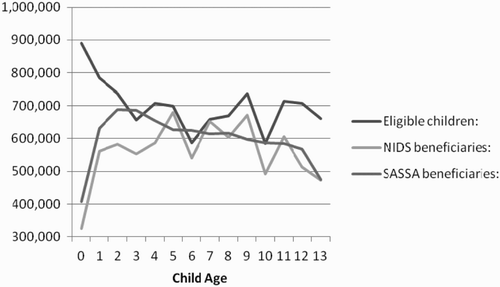
shows how simulated eligibility correlated with receipt of different types of child grants. Receipt of the Foster Care Grant and the Care Dependency Grant is not means tested but we found it useful to establish whether or not the Department of Social Development would consider children in receipt of these grants to be ‘in need’ in terms of the means test applied to their caregivers. We found that only about 2% of all Child Support Grant and Care Dependency Grant recipients did not meet the requirements of means testing, while the figure for Foster Care Grant recipients was 12%. It is important to note that these figures only included children up to the age of 14, while the Foster Care and Care Dependency Grants are in reality also available to children who are older.
Table 1: Simulated eligibility under the new means test by grant type in 2008
We found about 2.5 million children who were not (yet) receiving any form of social assistance, despite being simulated as eligible for the Child Support Grant (under the new means test). Much of this can be accounted for by the fact that we simulated eligibility under the new means test, whereas many households were interviewed prior to October 2008 when the new means test was implemented. This result suggests that even though the size and coverage of the Child Support Grant is substantial, there is still more room to increase take-up of the grant by eligible children.
3.4 Eligible but not receiving the grant
Those who were simulated as eligible but not in receipt of a grant provided many reasons in the survey as to why they did not apply. Over half a million caregivers (20% of those eligible and not receiving a grant) cited a lack of the correct documents as the reason. As Leatt et al. (Citation2005:16) point out, it is ‘generally the most poor who do not have birth certificates, are unable to travel to Home Affairs offices for identity documents, police stations for affidavits and the Department of Social Development for grant application processes’.
Another 11% of the eligible but not in receipt said they ‘hadn't got round to it yet’. This procrastination was characteristic mostly of caregivers with very young children: 47% of them were caregivers of children under 2 and two thirds were caregivers of children under 5. Since the early years of childhood strongly influence long-term health and education outcomes (Budlender & Woolard, Citation2006; Aguero et al., Citation2009), it is important to increase attempts to get these children into the grants system. An unexpected 8% of the eligible but not receiving said they ‘couldn't be bothered to apply’. Puzzlingly, these caregivers were typically poor, with an average mean income of R582 per month. It is unclear why they did not consider the value of the Child Support Grant, equivalent to almost half their average income, to be worth the effort of applying.
Many caregivers who were eligible but not receiving a grant were from the poorest households, with 40% having a household income per adult of less than R500 per month. These were likely to be rural households who had greater difficulty accessing documents such as birth certificates and would incur travel expenses in getting to the application point. In fact, a much higher percentage of poor households (28%) than other households cited lack of documents as the reason they had not applied for a grant.
3.5 Poverty in relation to grant receipt
The Child Support Grant is explicitly intended to be a poverty alleviation grant. Means testing criteria ensure that relatively better-off caregivers are excluded but they do not go further and ensure that the poorest of the poor are in receipt. Household income is not taken into account, only personal or joint spousal income, which may or may not reflect household poverty accurately.
To assess the poverty of those deemed eligible for the Child Support Grant through the means test, we evaluated whether the eligible population was also captured through other conventional measures of poverty. shows the percentage of eligible caregivers who are placed above or below a selection of traditional poverty lines. Most appear to fall below these lines, particularly the poverty lines derived for South Africa by Hoogeveen and Özler Citation(2006). Poverty gaps also appear to be extremely large, at 85% for the R949 line and 89% for the R515 line. This is because the caregivers' income came from a limited number of sources (i.e. labour income, private pensions, interest and rental income), so there was a high percentage (43%) with zero income values. Another 15% of caregivers were not living in the same household as the child and thus we were unable to measure their income.
Table 2: Poverty headcounts of caregivers eligible for the Child Support Grant
With coverage of 60% of all age-eligible children in 2008, the grant is remarkably extensive. Many previous problems with eligibility were resolved in August 2008, including biases against married couples and urban dwellers and a lack of inflationary adjustment. The targeting of the grant has been remarkably successful. Only 2% of caregivers receiving the grant were deemed ineligible (under the new means test) by our simulation and most of these still fell below other poverty lines.
4. Projecting the population to 2015
4.1 Mortality trends
South Africa's mortality figures have been greatly affected by the worsening of the HIV/AIDS pandemic. According to the ASSA 2003 model, HIV incidence peaked in 1998 and prevalence is expected to plateau in 2010. Incidence, prevalence and mortality all have an impact on different age categories and peak at different times.
Mortality is expected to increase in the 25 to 40 age range, particularly for women, between 2008 and 2015. This increase will affect the birth rate, as these are prime childbearing years, and also increase maternal orphanhood. Johnson and Dorrington Citation(2006) state that any decrease in maternal mortality due to treatment programmes (such as expanding access to antiretrovirals) is likely to be accompanied by a decrease in the mortality of children of infected women because of lower mother-to-child transmission rates.
Infant mortality rates are expected to decrease between 2008 and 2015 but all other age groups up to 17 are expected to show an increase in mortality. Those between the ages of 10 and 15 show particularly high increases, with the mortality rate approximately doubling over the period (see ). This is the result of a projected decrease in mother-to-child transmission, bringing down infant HIV/AIDS prevalence and mortality in 2015. Mortality estimates of those aged above 10 in 2015 are affected by mother-to-child transmission prior to 2005, when the incidence of this was much higher.
Figure 4: Mortality rates and growth by age between 2008 and 2015 FootnoteNotes.
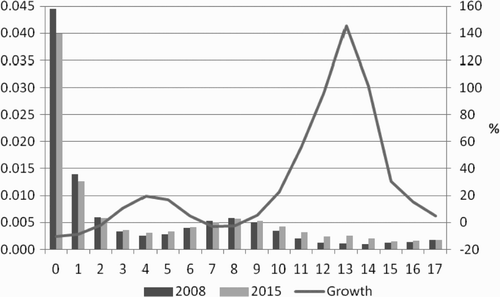
4.2 Fertility trends
Fertility in South Africa has been slowly declining over the past four decades (Moultrie, Citation2002; Moultrie & Timaeus, Citation2002, Citation2003; Moultrie & Dorrington, Citation2004). The average interval between births also doubled during this period from 30 months to 60 months (Moultrie, Citation2002; Timaeus & Moultrie, Citation2008). There is, however, some divergence in the estimates obtained from different sources. The 1998 DHS (Demographic and Health Survey) suggests that the total fertility rate (TFR) was 2.9 children per woman nationally, while the 1996 South African Census suggests a figure of 3.2 (Moultrie & Timaeus, Citation2003). Moultrie and Dorrington Citation(2004) derive estimates for the TFR of 2.8 children per woman nationally using the South African 2001 Census (see ).
Figure 5: National Total Fertility Rate and decline over time FootnoteNotes.
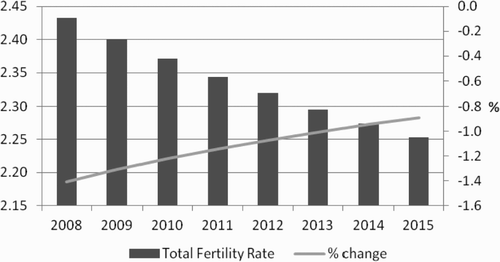
4.3 Age distribution trends
South Africa's age distribution (see ) exhibits the typical shape of a transitional population in which fertility has been falling for several decades. South Africa's population appears to be aging between 2008 and 2015, with a decreasing proportion of young people and an increasing proportion of the elderly. An analysis of the child population reveals a decrease in those aged 5 and under and an increase in those aged 12 to 17 between 2008 and 2015.
Figure 6: Population pyramids for 2008 (top) and 2015 (bottom) FootnoteNotes.
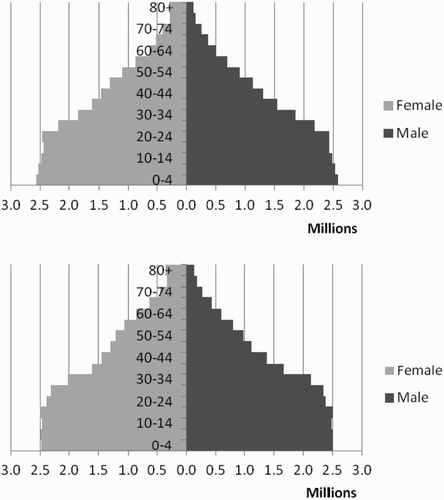
4.4 Methodology
To analyse eligibility and project fiscal costs forward to the year 2015 we constructed new sample weights for the NIDS dataset. The NIDS sample was re-weighted to resemble the population projections of the ASSA 2003 model for the years 2008 and 2015 based on province and age-race-sex cells, using a STATA program written by Martin Wittenberg Citation(2009). This provided a static simulation in which only the demographic structure of the population was altered. Other variables such as employment propensities and household structure were presumed to remain unchanged. This was clearly unrealistic, but it gave us insights into the impact of demographic change on fiscal costs. This methodology is commonly applied in the microsimulation literature (Orcutt, Citation1986).
4.5 Projecting the Child Support Grant to 2015
Examining Child Support Grant beneficiaries by age between 2008 and 2015, assuming that nothing changes in the eligibility rules for the grant, shows that the child population is not expected to change much over the next few years. This is a very important result as it emphasises that fiscal pressure will not be coming from a growing child population.
Future growth in the Child Support Grant will therefore only come from changes to the eligibility criteria. On 31 December 2009 the government published amendments to the Social Assistance Act which will progressively increase the age at which children are eligible for the Child Support Grant over the next few years. This will bring eligibility in line with the Constitution and the internationally accepted definition of a child. From 1 January 2010, 15 year olds are eligible, from 1 January 2011, 16 year olds will be eligible and from 1 January 2012 17 year olds will be eligible. As a result of this inclusion of older children the number of children eligible for the grant is projected to increase substantially by 2015 (see ).
Figure 7: Simulated eligibility for the Child Support Grant by age for 2008 and 2015 FootnoteNotes.
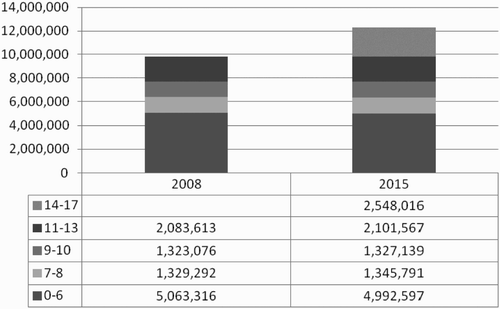
4.6 Child Grant cost projections
Government has estimated the cost of the age extension of the Child Support Grant up until the 2012/13 financial year in the Medium Term Budget Estimates. A useful exercise, however, is to extend this estimate to 2015 using the ASSA 2003 model projections. This provides a good alternative measure with which to compare government estimates.
We assumed that the value of the grant would be increased by 8% per annum, which we rounded off to R370 in 2015. We used the figure of 8% because it was the average yearly inflation in the Child Support Grant over the past 10 years. The predicted cost of the Child Support Grant in 2015 is shown in . While we could not simulate the cost of the Foster Care Grant (because its conditions for eligibility are more complex than can be captured through a survey), we included the historical costs of the Foster Care Grant for comparison.
Figure 8: Cost of child grant transfers, including estimates and a projection FootnoteNotes.
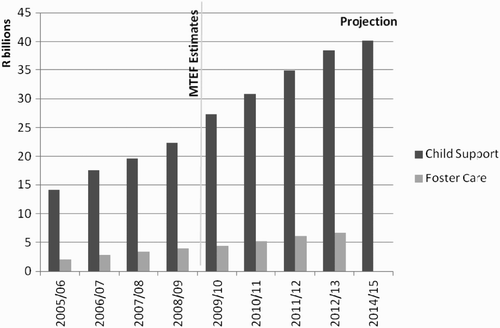
As can be seen in , the total cost of the Child Support Grant is expected to continue increasing up to 2015. Child Support Grant transfers are estimated to have grown by 22% by 2009, largely due to the inclusion of 14 year olds. The cost for the Child Support Grant in 2015 is estimated at just over R40 billion per year. Thus the Child Support Grant will have grown to represent a substantial portion of government spending. Nevertheless, this system is highly predictable and will soon reach steady-state. We now turn to an analysis of the Foster Care Grant, which is much less predictable and presents a greater fiscal risk.
5. The Foster Care Grant
5.1 Characteristics of beneficiaries
Unfortunately NIDS does not provide a comprehensive source of data for analysing Foster Care Grant beneficiaries, as it only includes information on child grants for children under 15, whereas SASSA figures indicate that 44% of all Foster Care Grants go to children aged 15 and over. Nevertheless, the profile of younger beneficiaries does provide useful insights.
The Foster Care Grant was not originally intended as a poverty alleviation grant and is therefore not means tested (except insofar as children with substantial incomes of their own are excluded). Despite this lack of a caregiver means test, the NIDS data indicate that 88% of Foster Care Grant beneficiaries live in households that would meet the means test requirements of the Child Support Grant.
While historically the Foster Care Grant only went to non-kin foster parents, it is interesting to note that in the NIDS data only 28% of Foster Care Grant recipients are explicitly referred to as ‘foster parents’ by the respondent. The most frequently reported recipient is the child's grandparent, at 36%, and another 12% report an aunt or uncle as the recipient.
5.2 Orphanhood and the Foster Care Grant
Almost three quarters of Foster Care Grant beneficiaries in the NIDS data are orphans. We find that for Foster Care Grant beneficiaries under 15, 10% are paternal orphans, 22% are maternal orphans and 42% are dual orphans. The ASSA 2003 model estimates that there were 4.3 million orphans in 2008 and predicts that there will be 4.8 million by 2015. This increase in the number of orphans is fuelled by increases in maternal mortality. Paternal orphanhood is predicted to remain stable, while maternal orphanhood will increase by 8% and dual orphanhood by a massive 79% from 628 000 to 1.1 million.Footnote1 Many of these new dual orphans would previously have been paternal orphans but will now become dual orphans because of the increased female mortality over this period.
Importantly, despite the high probability of a Foster Care Grant beneficiary being an orphan, the take-up of the Foster Care Grant by the caregivers of orphans is very low. In fact, orphans are more likely to receive a Child Support Grant than a Foster Care Grant. shows that the proportion of orphans under 15 receiving certain grants varies considerably across the three types of orphanhood. It appears that the absence of the child's mother hinders Child Support Grant receipt while the presence of the mother strongly decreases the likelihood of a Foster Care Grant.
Figure 9: Proportion of orphans under 15 who are receiving a grant FootnoteNotes.
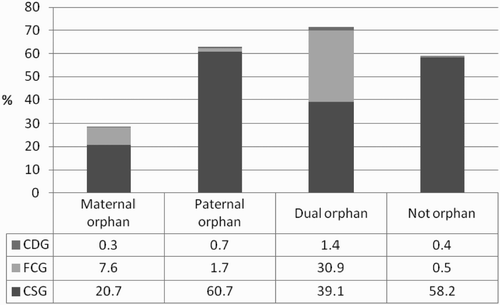
Maternal orphans appear significantly less likely to receive any form of grant than paternal or dual orphans or non-orphans. The reason for this is difficult to identify. About 12% of the caregivers of maternal orphans under 15 cite a lack of documents as the reason they have not applied for a grant but unfortunately the majority (69%) do not provide an answer to the question. The main area where maternal orphans appear to encounter significant difficulties is in accessing the Child Support Grant. Even dual orphans appear to be twice as likely as maternal orphans to receive a Child Support Grant. This result suggests that increasing the inclusion of maternal orphans in the Child Support Grant is a potentially important policy intervention.
Evidence from NIDS suggests that all categories of orphans are significantly worse off in terms of income than children whose parents are still alive. Average caregiver income for orphans is R792 for paternal orphans, R774 for maternal orphans and R297 for dual orphans. In comparison, the average caregiver income for children with both parents still living is R1935. If we look instead at household income, the figures are much higher but still exhibit the same trend, with the average income per adult in the household at R1010 for paternal orphans, R1191 for maternal orphans and R553 for dual orphans. The corresponding figure for children with both parents living is R2230.
5.3 Simulations for adjusting the Foster Care Grant to include orphans
The Foster Care Grant has increasingly become a de facto orphan grant, albeit one that is hard to access. However, while most recipients of this grant are orphans, most orphans are not receiving the Foster Care Grant. We therefore need to ask what the fiscal cost would be if the system were equalised and all orphans were able to access this grant. For the time being, we wish away the administrative constraints and assume that orphans can be easily identified, for example by means of the caregiver producing the death certificate for the child's parent(s).
Making the Foster Care Grant available to all orphans, maternal, paternal and dual, in 2008 would have added an additional 4.1 million children to the Foster Care Grant system. At the value of the grant in 2008 of R630, the additional cost would therefore have been R31 billion per year – 50% more than was spent on Child Support Grants in total that year. Even adjusting for orphans who would have been receiving the Child Support Grant at the time, the figure is a massive R27.7 billion for that year.
Since providing the Foster Care Grant to all orphans may well be fiscally unfeasible, let us consider a scenario where it is made available only to dual orphans. The burden of proof would be higher, particularly since it is difficult to establish whether or not the child's father is deceased if his whereabouts are unknown or he himself is unknown, but we again ignore this constraint for the purposes of illustrating the maximum cost of the scenario. Including all dual orphans would have doubled the number of Foster Care Grant beneficiaries in 2008 to 1 million children. It would have increased the cost from R3.7 billion to R7.2 billion per annum (after taking into account the removal of these children from the Child Support Grant system) (see ).
Table 3: Simulated cost of the Foster Care Grant in various scenarios during 2008
We are not arguing that this is the appropriate policy response, as it is unclear that the Foster Care Grant is the right policy prescription for orphans. We are simply seeking to clarify the fiscal costs of equalising the current system in which the Foster Care Grant is being used as an orphan grant for a minority of orphans. Given the pronouncements of former Minister Skweyiya quoted earlier, it is important to consider the implications of making the Foster Care Grant a de facto orphan grant.
5.4 Projection incorporating maternal orphans
The analysis above highlighted the low grant take-up rate for maternal orphans, in terms of both the Foster Care Grant and the Child Support Grant. The reasons for this remain unknown, although one might speculate that at least some of this lack of take-up is due to the difficulties involved in proving who the child's caregiver is when the mother is deceased. Other possibilities include children without a mother being less likely to be in possession of their birth certificate, or fathers attaching some form of stigma to applying for a grant which is typically paid to women. There is also the problem of misinformation, as caregivers may believe that certain documents are required, or that only a child's mother can apply for the Child Support Grant. An important area for future research and policy making would involve seeking a better understanding of why these maternal orphans are so much less likely to be grant recipients. Assuming that government intervention in this area would be successful and that all barriers to grant receipt for maternal orphans were removed, what impact would that intervention have on the cost of the Child Support Grant? In 2008 there were an estimated half a million maternal orphans not receiving any form of grant who were simulated in our data as being eligible. If all of these orphans had become grant recipients in 2008, the cost of the Child Support Grant would have increased by only R1.4 billion, which would have gone to some of the most vulnerable children in South Africa. Formulating a strategy to get these children into payment is a matter of urgency.
6. Conclusion
In this paper we have demonstrated that the key drivers of the increasing cost of the Child Support Grant have been the recent changes to the means test and the age eligibility criteria. The change to the means test in October 2008 resulted in an additional 1.7 million children becoming eligible for the grant, while the changes to age eligibility will increase the number of beneficiaries by an additional 2.5 million children between 2008 and 2015. Demographic projections suggest, however, that the child population will not grow over this period, so there will not be additional fiscal pressure on the Child Support Grant emanating from population growth.
The Foster Care Grant represents a much greater fiscal risk. We find that three quarters of Foster Care Grant beneficiaries are orphans, suggesting that this grant is becoming an unofficial ‘orphan grant’. At the same time, most orphans are not getting the Foster Care Grant, at least in part because of the burdensome process of applying for the grant and the lack of enough social workers to cope with the associated case loads. This ‘rationing’ of Foster Care Grants is surely inequitable.
In the context of high adult mortality, the number of orphans is growing rapidly. This amplifies the urgency for government to clarify whether it intends to increase capacity and extend the Foster Care Grant to far greater numbers of orphans. If this is the intention, then it will have substantial cost implications.
In the short term, we have highlighted the pressing need for maternal orphans to be brought into the child grant system. Many of these children are entitled to the Child Support Grant yet are not receiving it. We have speculated that part of the reason for this might be the perception that the Child Support Grant is a grant for mothers. Certainly the fact that 99% of Child Support Grant beneficiaries are women suggests that men think that they either cannot or should not access this grant. This perception can only be altered through an extensive media campaign.
Notes
Source: Personal communication, V Mahlangu, SASSA, 11 September 2009.
Notes: The figures for 2001, 2002 and 2003 are for April, and since the age limit was only increased to those under 9 in April 2003 there is no value for the 7–8 age group for this year. From 2004 onwards all other figures are for September and thus encompass any changes that took place during that year.
Source: Personal communication, V Mahlangu, SASSA, 11 September 2009.
Source: Personal communication, V Mahlangu, SASSA, 11 September 2009; SALDRU (2008).
Source: ASSA 2003 HIV/AIDS model (full) (ASSA, Citation2005).
Source: ASSA (2003) HIV/AIDS model (full) (ASSA, 2005).
Source: ASSA 2003 HIV/AIDS model (full) (ASSA, 2005).
Source: SALDRU (2008). Own calculations.
Source: National Treasury (Citation2010:chapters 6 and 7).
Note: These figures are for cash transfers only and do not include administrative and other costs.
1Note that the three orphanhood statuses are of course mutually exclusive.
Notes: Orphanhood status of grant beneficiaries is derived from NIDS (SALDRU, 2008) and total orphans under 14 is taken from the ASSA 2003 model (ASSA, 2005). CDG = Care Dependency Grant, FCG = Foster Care Grant, CSG = Child Support Grant.
References
- Aguero, J , Carter, M , and Woolard, I , 2009. (2009), The impact of unconditional cash transfers on nutrition: The South African Child Support Grant. IPC Working Paper 39, International Poverty Centre, Brasilia.
- ASSA (Actuarial Society of South Africa), 2005. (2005), ASSA 2003 AIDS and demographic model. http://aids.actuarialsociety.org.za/ Accessed 19 November 2009.
- Budlender, D , and Woolard, I , 2006. (2006), The impact of the South African Child Support and Old Age Grants on children's schooling and work. Study prepared for the International Programme on the Elimination of Child Labour, International Labour Organisation, Geneva.
- Budlender, D , Proudlock, P , and Jamieson, L , 2008. "Developing social policy for children in the context of HIV/AIDS: A South African case study". In: Children's Institute Case Study No. 3 . Cape Town: Children's Institute, University of Cape Town, and Community Agency for Social Enquiry; 2008.
- Hoogeveen, J , and Özler, B , 2006. "Poverty and inequality in post-apartheid South Africa: 1995–2000". In: Bhorat, H , and Kanbur, R , eds. Poverty and Policy in Post-Apartheid South Africa . Cape Town: HSRC (Human Sciences Research Council) Press; 2006. pp. 59–94.
- Johnson, L , and Dorrington, R , 2006. Modelling the demographic impact of HIV/AIDS in South Africa and the likely impact of interventions , Demographic Research 14 (22) (2006), pp. 541–74.
- Kruger, J , 1998. From single parents to poor children: Refocusing South Africa's transfers to poor households with children . Presented at Paper presented at ISSA (International Social Security Association) Second International Research Conference on Social Security. Jerusalem, 25–28, January.
- Leatt, A , Rosa, S , and Hall, K , 2005. "Towards a means to live: Targeting poverty alleviation to realise children's rights". In: Leatt, A , and Rosa, S , eds. Towards a Means to Live: Targeting Poverty Alleviation to Make Children's Rights Real . Cape Town: Children's Institute, University of Cape Town; 2005.
- Meintjes, H , Giese, S , Budlender, D , and Johnson, L , 2003. "Children ‘in need of care’ or in need of cash? Questioning social security provisions for orphans in the context of the South African AIDS pandemic". In: Joint working paper of the Children's Institute and the Centre for Actuarial Research . University of Cape Town; 2003.
- Moultrie, T , 2002. Apartheid's children: Social institutions and birth intervals during the South African fertility decline, 1960–1998 , (2002), PhD thesis, University of London.
- Moultrie, T , and Dorrington, R , 2004. "Estimation of fertility from the 2001 South African census data". Centre for Actuarial Research, University of Cape Town; 2004, CARe Monograph No. 12.
- Moultrie, T , and Timaeus, I , 2002. "Trends in South African fertility between 1970 and 1998: An analysis of the 1996 Census and the 1998 Demographic and Health Survey". In: Medical Research Council . Cape Town. 2002, www.mrc.ac.za/bod/trends.pdf Accessed 1 September 2010.
- Moultrie, T , and Timaeus, I , 2003. The South African fertility decline: Evidence from two censuses and a demographic and health survey , Population Studies 57 (3) (2003), pp. 265–83.
- National Treasury, 2010. Budget Review 2010 . Pretoria: Government Printer; 2010.
- Orcutt, G , 1986. "Views on microanalytic simulation modelling". In: Orcutt, G , Merz, J , and Quinke, H , eds. Microanalytic Simulation Models to Support Social and Financial Policy . Amsterdam: North-Holland; 1986.
- SALDRU (South Africa Labour and Development Research Unit), 2008. National Income Dynamics Study. Dataset . Cape Town: SALDRU; 2008.
- Skweyiya, Z , 2007. (2007), Address by Dr ZST Skweyiya, Minister of Social Development, at the Second Reading of the Children's Amendment Bill Debate, National Assembly, Cape Town. www.polity.org.za/article/sa-skweyiya-second-reading-of-childrens-amendment-bill-debate-06112007-2007-11-06 Accessed 29 September 2010.
- Timaeus, I , and Moultrie, T , 2008. On postponement and birth intervals , Population and Development Review 34 (3) (2008), pp. 483–510.
- Wittenberg, M , 2009. (2009), Sample survey calibration: An information-theoretic perspective. Unpublished mimeograph, SALDRU (Southern Africa Labour and Development Research Unit), University of Cape Town.
- Woolard, I , and Leibbrandt, M , 2010. (2010), The evolution and impact of unconditional cash transfers in South Africa. SALDRU (Southern Africa Labour and Development Research Unit) Working Paper 51, University of Cape Town.